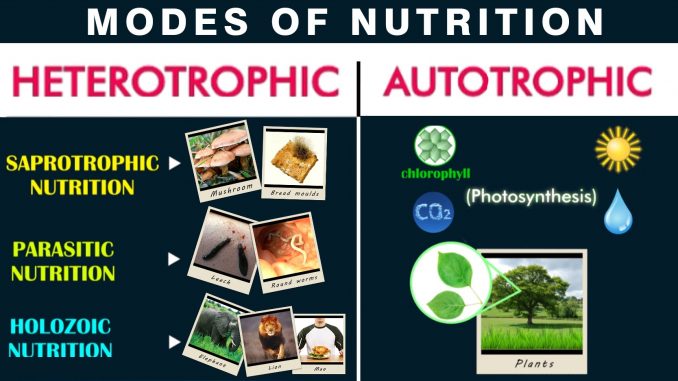
Nutrition and mode of nutrition
Nutrition
- Nutrition is the physiological process of acquiring energy for the metabolic activities, growth or other life processes. The organism acquired the energy from food. So, the process of obtaining food (nutrients) is simply known as nutrition.
Mode of Nutrition: on the basis of mode of acquiring food
1. Autotrophic mode of nutrition:
- It is also known as holophytic mode (plant like nutrition). Organisms can synthesize all the essential nutrients required for them from inorganic substrates (CO2, NH3, nitrates, water etc) present in the environments. It is of two types.
i) Phototropic nutrition: Organisms synthesize their food in the presence of sun light using Carbon-dioxide and water as substrate. Such organisms are known as Photo-Autotrophs. Eg. Green plants
ii) Chemotropic nutrition: Organisms synthesis their organic food by the chemical reactions (Oxidation) utilizing inorganic substrates like nitrates, Hydrogen sulphate, iron etc. such organisms are known as chemo-autotrophs. Eg. Sulphur bacteria, Nitrobacter, Nitromonas etc.2.
2. Heterotropic mode of nutrition:
- organisms cannot synthesize their food by themselves rather they depend on the food prepared by Autotrophs (directly or indirectly). Such organisms are known as heterotrophs. According to the types of food or mode of feeding, heterotropic nutrition are o following types
i) Holozoic nutrition: it is known as animal-like mode of nutrition. In this mode, animals feed on plants or other animals whole or their parts for food. Such animals are free living and have the characteristics of Ingestion, digestion, absorption, assimilation and egestion. Such animals are classified into following types
- Herbivorous: Animals which feed on plants for nutrition. Eg. Cow , goat, buffalo etc
- Carnivorous: Animals which feed on other animals or animal products. Eg. Tiger, lion
- Omnivorous: Animals having mixed diets (feeding on both animals and plants and their products). Eg. Human, crow
- Coprophagous: Animals feeding upon faeces of other animlals. Eg. Pig
- Cannibalism: Animals feeding upon smaller animals of same species. Eg. Snakes, frog
- Sanguivorous: Animals feeding upon blood. Eg. Leech, Vampire bat
ii) Saprotrophic nutrition: organisms obtain their nutrition from dead and decaying organic matter. They are decomposers. Eg. Fungi, bacteria, earthworm etc. They includes saprophytes and saprozoic.
iii) Symbiotic nutrition: In symbiosis two or more organisms of different species live together in close association. Nutrition involved in symbiotic association are
- Parasitism: One partner (parasite) depend completely upon other partner (Host) for nutrition. Parasites living outside host body known as ecto-parasites Eg. Leech, ticks etc. and those parasites living inside host body known as endoparasites. Eg. Plasmodium, Taenia solium.
- Mutualism: both partner organisms get benefit from each other. Eg. Lichen, Rhizobium on root nodules of legumes.
- Commensalism: one partner get benefit which other neither harmed or benifited. Eg. E. coli in Human gut
